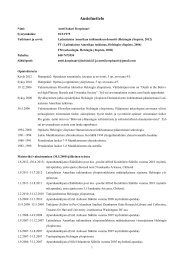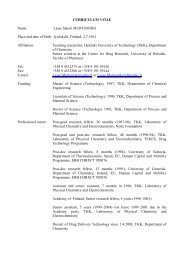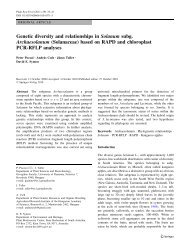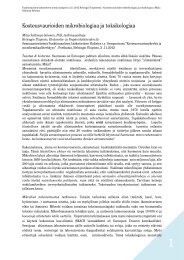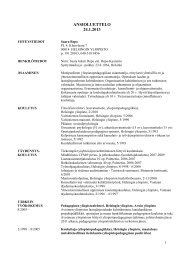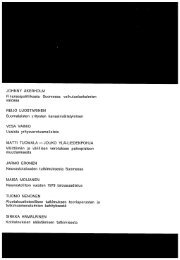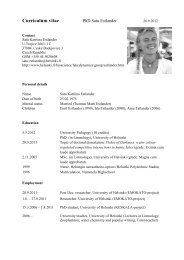Finnish Romani and other northern dialects of Romani in the Baltic ...
Finnish Romani and other northern dialects of Romani in the Baltic ...
Finnish Romani and other northern dialects of Romani in the Baltic ...
Create successful ePaper yourself
Turn your PDF publications into a flip-book with our unique Google optimized e-Paper software.
<strong>F<strong>in</strong>nish</strong> <strong>Romani</strong> <strong>and</strong>… An Introduction (1)• A four-year (Jan 1, 2013–Dec 31, 2016) project led by university lecturer,docent Kimmo Granqvist; co-funded by <strong>the</strong> University <strong>of</strong> Hels<strong>in</strong>ki <strong>and</strong> <strong>the</strong>Kone Foundation Language Program.• L<strong>in</strong>ked to General L<strong>in</strong>guistics, studies <strong>of</strong> Indo-European, Balkan, Slavonic,Germanic <strong>and</strong> <strong>Baltic</strong> languages, <strong>and</strong> Fennistics.• The size <strong>of</strong> <strong>the</strong> Roma population <strong>in</strong> Pol<strong>and</strong>, Russian Federation, <strong>the</strong> <strong>Baltic</strong>Countries, Germany <strong>and</strong> F<strong>in</strong>l<strong>and</strong> is at least 300,000.• Most <strong>Romani</strong> <strong>dialects</strong> spoken <strong>in</strong> <strong>the</strong> <strong>Baltic</strong> Sea area belong to <strong>nor<strong>the</strong>rn</strong><strong>dialects</strong>:• a meta-group divided <strong>in</strong>to Northwestern (German <strong>and</strong> Polish S<strong>in</strong>ti <strong>and</strong> <strong>F<strong>in</strong>nish</strong><strong>Romani</strong>) <strong>and</strong> Nor<strong>the</strong>astern (most <strong>Romani</strong> <strong>dialects</strong> spoken <strong>in</strong> Pol<strong>and</strong>, Lithuania, Latvia,Estonia <strong>and</strong> Russia) sub-branches.
<strong>F<strong>in</strong>nish</strong> <strong>Romani</strong> <strong>and</strong>… An Introduction (2)Figure 1. <strong>Romani</strong> <strong>dialects</strong> <strong>in</strong> <strong>the</strong> <strong>Baltic</strong> Sea Area.
Practical outputs• corpora: 121 new dialect samples (CSC), dialect samples added to <strong>the</strong>RMS database (<strong>the</strong> largest corpus <strong>of</strong> <strong>nor<strong>the</strong>rn</strong> <strong>and</strong> <strong>o<strong>the</strong>r</strong> <strong>dialects</strong>);• six pr<strong>in</strong>ted/onl<strong>in</strong>e books: atlas <strong>of</strong> Nor<strong>the</strong>rn <strong>dialects</strong> <strong>of</strong> <strong>Romani</strong> <strong>in</strong> <strong>the</strong><strong>Baltic</strong> Sea area, descriptive grammar <strong>of</strong> <strong>F<strong>in</strong>nish</strong> <strong>Romani</strong>, textbook <strong>of</strong><strong>Romani</strong> language history, critical edition <strong>of</strong> 19th century manuscripts<strong>of</strong> <strong>F<strong>in</strong>nish</strong> <strong>Romani</strong>, two PhD <strong>the</strong>ses;• research papers <strong>and</strong> conference presentations, popular articles;• presentations at project events, <strong>and</strong> on <strong>the</strong> project website.
Subproject A (4)
Subproject B: <strong>F<strong>in</strong>nish</strong> <strong>Romani</strong> <strong>and</strong> <strong>o<strong>the</strong>r</strong><strong>nor<strong>the</strong>rn</strong> <strong>dialects</strong> (2014–2017)• The atlas <strong>of</strong> <strong>nor<strong>the</strong>rn</strong> <strong>dialects</strong> <strong>of</strong> <strong>Romani</strong> <strong>in</strong> <strong>the</strong> <strong>Baltic</strong> Sea area willdescribe <strong>the</strong> most important:• a) phonetic <strong>and</strong> phonological (ca. 10 maps),• b) morphological <strong>and</strong> grammatical category-related (ca. 100 maps),• c) lexical <strong>and</strong> lexicophonological (ca. 40 maps)features that are relevant for <strong>the</strong> classification <strong>and</strong> comparison <strong>of</strong> <strong>nor<strong>the</strong>rn</strong><strong>dialects</strong>.• The atlas will fur<strong>the</strong>rmore discuss isoglosses <strong>of</strong> <strong>nor<strong>the</strong>rn</strong> <strong>dialects</strong> <strong>and</strong><strong>F<strong>in</strong>nish</strong> <strong>Romani</strong>, <strong>and</strong> <strong>the</strong> relationship <strong>of</strong> <strong>nor<strong>the</strong>rn</strong> <strong>dialects</strong> <strong>and</strong><strong>nor<strong>the</strong>rn</strong> central <strong>dialects</strong> <strong>of</strong> <strong>Romani</strong>.
Sub-projects C <strong>and</strong> D: Descriptive grammar <strong>of</strong> <strong>F<strong>in</strong>nish</strong><strong>Romani</strong> (2014–2017), history <strong>of</strong> <strong>F<strong>in</strong>nish</strong> <strong>Romani</strong> (2011–2016):• Sub-projects C <strong>and</strong> D will be based on analysis <strong>of</strong> grammatical categories<strong>and</strong> relationships from <strong>the</strong> po<strong>in</strong>t <strong>of</strong> view <strong>of</strong> morpho-syntactic typology.• The sub-projects will also deal with descriptive <strong>and</strong> historical phonology.• The sub-projects will take an attitude to <strong>Romani</strong> dialectology, contactl<strong>in</strong>guistics <strong>and</strong> <strong>the</strong> study <strong>of</strong> code-switch<strong>in</strong>g, borrow<strong>in</strong>g <strong>and</strong> attrition.• Sub-project C will look at <strong>F<strong>in</strong>nish</strong> <strong>Romani</strong> from a synchronic po<strong>in</strong>t <strong>of</strong> view.• In sub-project D, <strong>the</strong> focus is on developments that have taken place <strong>in</strong>F<strong>in</strong>l<strong>and</strong> with<strong>in</strong> <strong>the</strong> light <strong>of</strong> preserved documents s<strong>in</strong>ce <strong>the</strong> end <strong>of</strong> <strong>the</strong> 18thcentury.
National <strong>and</strong> <strong>in</strong>ternational collaboration• The project is carried out at <strong>the</strong> Department <strong>of</strong> <strong>F<strong>in</strong>nish</strong>, F<strong>in</strong>no-Ugrian<strong>and</strong> Sc<strong>and</strong><strong>in</strong>avian Studies at <strong>the</strong> University <strong>of</strong> Hels<strong>in</strong>ki.• The project is l<strong>in</strong>ked to General L<strong>in</strong>guistics, studies <strong>of</strong> Indo-European, Balkan,Slavonic, Germanic <strong>and</strong> <strong>Baltic</strong> languages, <strong>and</strong> Fennistics.• The PhD <strong>the</strong>ses produced are co-supervised by Kimmo Granqvist <strong>and</strong> scholarsspecialized <strong>in</strong> research <strong>of</strong> <strong>in</strong>teraction <strong>and</strong> grammar at different departments<strong>of</strong> <strong>the</strong> University <strong>of</strong> Hels<strong>in</strong>ki.• The project fur<strong>the</strong>rmore co-operates with CSC <strong>in</strong> <strong>the</strong> onl<strong>in</strong>e publication <strong>of</strong> <strong>the</strong>data.• The project co-operates with academic scholars <strong>in</strong> Sweden, CzechRepublic, Russia <strong>and</strong> <strong>the</strong> UK.
O<strong>the</strong>r <strong>and</strong> future plans• Currently <strong>the</strong>re is a parallel project at UH on <strong>Romani</strong> Identity <strong>and</strong>Au<strong>the</strong>nticity, which will see collaboration <strong>of</strong> anthropologists <strong>and</strong>l<strong>in</strong>guists.• An<strong>o<strong>the</strong>r</strong> project, Microdialectology <strong>of</strong> <strong>Romani</strong> <strong>in</strong> <strong>the</strong> <strong>Baltic</strong>s, isawait<strong>in</strong>g fund<strong>in</strong>g.
Thank you for listen<strong>in</strong>g!






